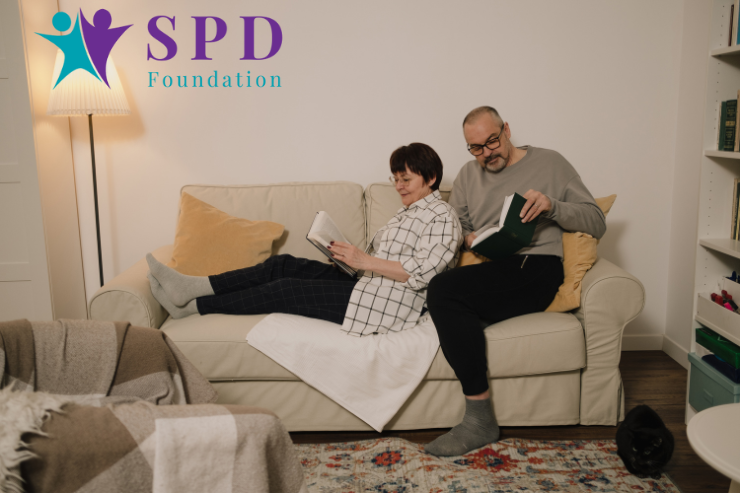The constant barrage of sensory information can be incredibly distressing for someone with SPD. Imagine hearing every background noise amplified or finding the light touch of a cotton shirt unbearable.
This relentless sensory overload can induce chronic stress and fatigue, creating a fertile ground for depression. The brain’s ongoing struggle to process these inputs can upset its hormonal and emotional balance, increasing the risk of depressive symptoms.
Social Challenges and Isolation

Social interactions often pose significant challenges for individuals with SPD. Environments with loud conversations, bright lights, and casual touches, which are commonplace in social settings, can be daunting.
This often leads to social withdrawal, as the sensory discomfort pushes individuals to avoid such interactions. Unfortunately, this withdrawal fosters isolation and loneliness, exacerbating feelings of sadness and contributing to the development of depression.
Sleep Disturbances Compound Problems

Sleep is crucial for overall well-being, but for those with SPD, it can be fraught with challenges. Minor disturbances like ambient noises or uncomfortable bedclothes can disrupt sleep, leading to sleep deprivation.
In turn, insufficient sleep affects mood regulation and increases irritability, which can worsen depressive symptoms. This creates a vicious cycle, where poor sleep deepens depression, and depression further disrupts sleep.
The Mental Load of Coping Mechanisms

Living with SPD requires constant mental and emotional effort to manage discomfort and try to function in a world not designed for sensory sensitivities. This ongoing effort can be exhausting, leading to feelings of helplessness and despair, which are hallmark symptoms of depression.
The effort to maintain normalcy and manage sensory inputs can diminish a person’s ability to enjoy life and feel successful, further fueling depressive feelings.
Comorbidities and Treatment Complexities

Effective treatment for individuals facing both SPD and depression must be integrative, addressing both the sensory challenges and the emotional distress. This might involve a combination of therapies:
- Occupational Therapy: Primarily used to help individuals with SPD develop skills to better process and respond to sensory information. Occupational therapists often use sensory integration techniques to help patients manage their sensitivities more effectively.
- Psychotherapy: Especially cognitive-behavioral therapy (CBT), which can be effective in treating depression by helping individuals develop coping strategies to manage negative thought patterns. CBT can also be adapted to help patients better understand and regulate the emotions resulting from sensory overload.
- Medication: In some cases, antidepressants or anti-anxiety medications may be prescribed to help manage the symptoms of depression or anxiety resulting from or contributing to SPD. Medication can sometimes help to stabilize mood and reduce the overall emotional impact of sensory overstimulation.
- Lifestyle Adjustments: Encouraging patients to modify their lifestyle to reduce sensory stressors can also be beneficial. This might include creating a more sensory-friendly home environment, using noise-canceling headphones in noisy situations, or wearing clothing made of specific fabrics that are more comfortable.
- Education and Support: Educating patients and their families about both conditions is crucial. Understanding how sensory processing issues can impact emotional health and vice versa empowers individuals and their caregivers to make informed decisions about daily activities and interventions.
One of the main challenges in treating comorbid SPD and depression is the lack of widespread recognition and understanding of SPD. Many healthcare providers are not fully aware of SPD or how deeply it can impact an individual’s mental health.
Treatments that work for one person may not be effective for another due to the highly individualistic nature of SPD and depression. This necessitates a highly personalized treatment plan, which can be resource-intensive to develop and implement.
New Research and Treatment Approaches
Recent advances in neuroscience have enhanced our understanding of Sensory Processing Disorder (SPD) and its frequent comorbidity with depression. Research examining the neurological structures and functions shared by both conditions highlights how they might intersect and influence one another.
This growing body of knowledge is pivotal in shaping more effective, holistic treatment approaches that address the complex interplay of sensory processing and emotional regulation.
Neurological Overlaps in SPD and Depression
- Amygdala: Known for its role in emotional processing, the amygdala has been a focal point in depression research for its part in fear and stress responses. Studies show that individuals with depression often exhibit heightened amygdala activity in response to negative emotional stimuli. Similarly, research into SPD shows abnormal amygdala responses to sensory stimuli, suggesting that the sensory overload experienced by individuals with SPD could trigger emotional responses that contribute to anxiety and depression.
- Prefrontal Cortex: This area of the brain is crucial for executive functions such as planning, decision-making, and moderating social behavior. In depression, the prefrontal cortex often shows reduced activity, which correlates with difficulties in concentration and decision-making. In SPD, research has indicated that there might be disruptions in how this region processes sensory information, which could exacerbate the cognitive and emotional symptoms seen in depression.
- Connectivity Issues: Recent imaging studies have suggested that both SPD and depression are associated with altered connectivity within the brain’s sensory and emotional regulation networks. These studies propose that disruptions in neural pathways, not just localized brain areas, play a role in the manifestation of symptoms common to both disorders.
Innovative Treatment Approaches
Given the overlaps in brain function and structure, treatments that are typically used for sensory integration in SPD are being adapted to also address depressive symptoms. Here are some emerging approaches:
- Occupational Therapy with a Dual Focus: Traditional occupational therapy for SPD often involves sensory integration techniques that help individuals better process and react to sensory information. Now, therapists are incorporating strategies to manage stress and emotional responses associated with sensory overload, effectively tackling both SPD and depression symptoms simultaneously.
- Cognitive-Behavioral Therapy (CBT): While CBT is a standard treatment for depression, it’s increasingly being tailored to help those with SPD manage the negative thoughts and stress that arise from dealing with overwhelming sensory environments. This tailored CBT helps patients develop coping strategies that address both sensory sensitivities and depressive thoughts.
- Neurofeedback: This is a type of biofeedback that uses real-time displays of brain activity—typically through EEG—to teach self-regulation of brain function. Neurofeedback is being explored for individuals with SPD to help them modulate their responses to sensory stimuli and is also used in the treatment of depression to help regulate mood.
- Integrative Lifestyle Changes: Incorporating structured routines and environments designed to reduce sensory stress can also mitigate symptoms of depression. This includes modifications like using dimmable lighting, noise reduction tools, and tactile-friendly clothing and furniture, which can help create a more comforting environment conducive to emotional and sensory regulation.







